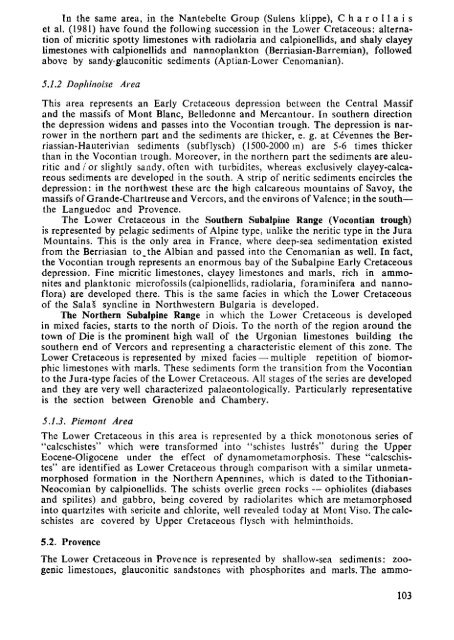THE MEDITERRANEAN LOWER CRETACEOUS
THE MEDITERRANEAN LOWER CRETACEOUS
THE MEDITERRANEAN LOWER CRETACEOUS
Create successful ePaper yourself
Turn your PDF publications into a flip-book with our unique Google optimized e-Paper software.
Tn the same area, in the Nantebelte Group (Sulens klippe), С h a г о 1 1 a i s<br />
et al. (1981) have found the following succession in the Lower Cretaceous: alternation<br />
of micritic spotty limestones with radiolaria and calpionellids, and shaly clayey<br />
limestones with calpionellids and nannoplankton (Berriasian-Barremian), followed<br />
above by sandy-glauconitic sediments (Aptian-Lower Cenomanian).<br />
5.1.2 Dophinoise Area<br />
This area represents an Early Cretaceous depression between the Central Massif<br />
and the massifs of Mont Blanc, Belledonne and Mercantour. In southern direction<br />
the depression widens and passes into the Vocontian trough. The depression is narrower<br />
in the northern part and the sediments are thicker, e. g. at Cévennes the Berriassian-Hauterivian<br />
sediments (subflysch) (1500-2000 m) are 5-6 times thicker<br />
than in the Vocontian trough. Moreover, in the northern part the sediments are aleuritic<br />
and / or slightly sandy, often with turbidites, whereas exclusively clayey-calcareous<br />
sediments are developed in the south. A strip of neritic sediments encircles the<br />
depression: in the northwest these are the high calcareous mountains of Savoy, the<br />
massifs of Grande-Chartreuse and Vercors, and the environs of Valence; in the south—<br />
the Languedoc and Provence.<br />
The Lower Cretaceous in the Southern Subalpine Range (Vocontian trough)<br />
is represented by pelagic sediments of Alpine type, unlike the neritic type in the Jura<br />
Mountains. This is the only area in France, where deep-sea sedimentation existed<br />
from the Berriasian to^the Albian and passed into the Cenomanian as well. In fact,<br />
the Vocontian trough represents an enormous bay of the Subalpine Early Cretaceous<br />
depression. Fine micritic limestones, clayey limestones and marls, rich in ammonites<br />
and planktonic microfossils (calpionellids, radiolaria, foraminifera and nannoflora)<br />
are developed there. This is the same facies in which the Lower Cretaceous<br />
of the Salas -<br />
syncline in Northwestern Bulgaria is developed.<br />
The Northern Subalpine Range in which the Lower Cretaceous is developed<br />
in mixed facies, starts to the north of Diois. To the north of the region around the<br />
town of Die is the prominent high wall of the Urgonian limestones building the<br />
southern end of Vercors and representing a characteristic element of this zone. The<br />
Lower Cretaceous is represented by mixed facies — multiple repetition of biomorphic<br />
limestones with marls. These sediments form the transition from the Vocontian<br />
to the Jura-type facies of the Lower Cretaceous. All stages of the series are developed<br />
and they are very well characterized palaeontologically. Particularly representative<br />
is the section between Grenoble and Chambery.<br />
5.1.3. Piémont Area<br />
The Lower Cretaceous in this area is represented by a thick monotonous series of<br />
"calcschistes" which were transformed into "schistes lustrés" during the Upper<br />
Eocene-Oligocene under the effect of dynamometamorphosis. These "calcschistes"<br />
are identified as Lower Cretaceous through comparison with a similar unmetamorphosed<br />
formation in the Northern Apennines, which is dated to the Tithonian-<br />
Neocoinian by calpionellids. The schists overlie green rocks — ophiolites (diabases<br />
and spilites) and gabbro, being covered by radiolarites which are metamorphosed<br />
into quartzites with sericite and chlorite, well revealed today at Mont Viso. The calcschistes<br />
are covered by Upper Cretaceous flysch with helminthoids.<br />
5.2. Provence<br />
The Lower Cretaceous in Provence is represented by shallow-sea sediments: zoogenic<br />
limestones, glauconitic sandstones with phosphorites and marls. The ammo-<br />
103

















